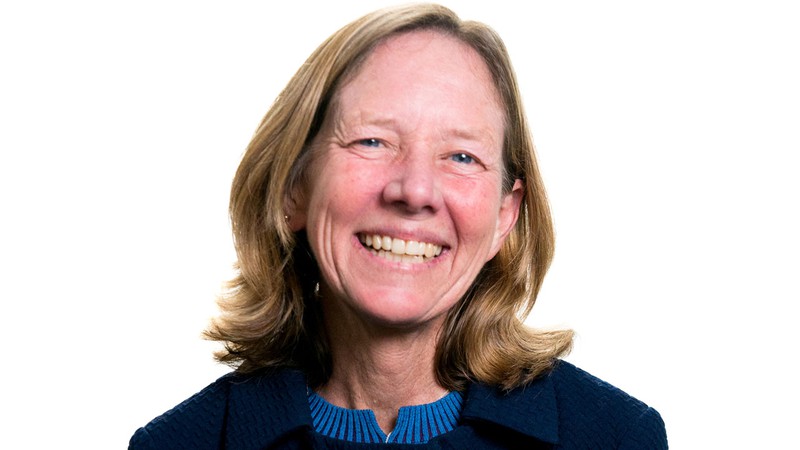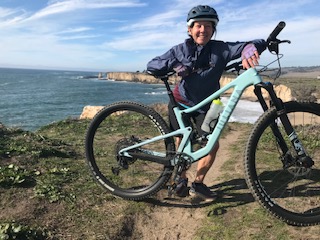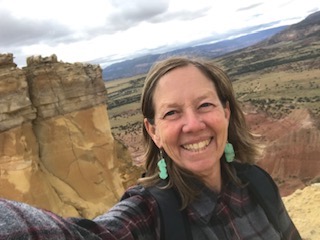As the strategic fund development director, she works to make the Santa Cruz-based nonprofit Ecology Action greener

A background in documentary filmmaking taught Jeanne LePage how to raise the money needed to make big projects happen. Ecology Action
As a Northern California native, Jeanne LePage grew up with a keen appreciation for the natural world. Her mother, an avid outdoorswoman “long before it was normal for women to go do things outside by themselves,” instilled in LePage a love and appreciation of nature and the environment from a young age. “It’s in my DNA,” she says.
For a short time after high school, LePage left the area to attend UC San Diego, but that community wasn’t the right fit. She returned and enrolled at UC Santa Cruz, where she fell in love with environmental studies and found camaraderie with fellow students who wanted to make the world a better place.
As a documentary filmmaker in the early years of her career, LePage made impactful, thought-provoking films that exposed inequity and pushed for social change. The work required her to learn how to raise the funds to support and produce her films—a skill that proved valuable when she transitioned to working with Ecology Action, a nonprofit environmental group based in Santa Cruz.
Now, after more than a decade, LePage can be credited with leading some of the organization’s most impactful community projects. These include the design and implementation of the Safe Routes to School project, which created bike paths throughout the Monterey Bay area.
LePage recently sat down with California Local to talk about her early career, her work with Ecology Action, and how she stays motivated to keep bettering her community and the planet. This interview has been edited for length and clarity.
California Local: How did you get into filmmaking and what was your career like?
Jeanne LePage: After college, I took some time to travel, and was backpacking through Europe when I found out I was accepted to the documentary film program at Stanford. It was a two-year program with a small group of students. For the most part, people were in that program because they wanted to make a difference. They wanted to tell stories that would change the world for the better.
My thesis film was on acquaintance rape, and it was about putting rape into a social context of how we view women and how women are depicted in films and other media. That was in 1985, and it took off like wildfire. Documentary films usually don’t make money, but this one did, because it was just the right topic at the right time. It was picked up by universities all over the country, and in some other countries as well. Oprah Winfrey’s staff called to see if I would come on the show, but I suggested she talk to people that are actually in the film, and re-interview them, so she ended up doing that. It was a pretty amazing experience, I really had a wonderful ride with that film.
After that, I was living in Big Sur and decided I wanted to make a film about the ongoing controversy surrounding the issue of granting Big Sur national park status. So I wrote grants to be able to support that film.
As a documentary filmmaker, you learn how to do development work, which is what I’m doing now. That experience kind of set me on my path.
How did you get started with Ecology Action?
I had friends that worked at Ecology Action so I was familiar with the organization. I was hired during Obama’s inauguration, in 2008. My position at the time was working in the schools to implement the climate education program for elementary school students. At that time, I was given a wide range to be able to develop the program, research the curriculum, and then figure out what would be appropriate to bring into the schools. I loved it.
I have always resided in Ecology Action’s Community Programs. We’re the local face that most people know of when they think of Ecology Action. Community Programs produced Bike to Work, which is now Love to Ride, and Bike to School. We also offer bicycle and pedestrian safety programming, water conservation projects, and eclectic vehicle programs.
What kind of work do you do now, as the strategic fund development director?
When you’re in Community Programs, you’re always looking for funding to help support your work, and I had a background doing that and had writing experience. In fact, I wrote my first grant when I was in college as an undergraduate student so I could study in Alaska. So I had that skill set in my back pocket.

Then once the organization brought in large grants, we ended up with a separate development team—there are now four of us on the team. That’s exclusively what I do now, and there’s a lot of opportunity.
A big part of what I do is build relationships with external partners—finding out what opportunities lie ahead, where their priorities are, what their interests are, and how Ecology Action can help support and strengthen their mission. For example, last week I was helping the city of Watsonville with an application for a statewide competition. I looked at multiple planning documents that the city has created, and was grabbing nuggets of information that would be good for this application. In the process, I built my own portrait of the city and where it’s going. That kind of work is really fun for me.
What keeps you motivated to keep doing this work?
I feel like I have longstanding respectful partners, many of whom have become good friends, and I think that’s a testament to the fact that we’re all drawn to do similar good work.
The people I work with in the organization are on the same page as me. I feel like I’ve really found my tribe. I don’t need to explain things, like why I wash my plastic bags because it’s just kind of understood that it’s like one of your basic moral tenets. That seems so important to me, especially as we face climate change.
You want to have your tribe with you to be able to be renewed and to have the energy to go out there and fight the good fight. Both inside and outside the organization, there’s a lot of juice that keeps me going.
Some of our work is incremental, but then some of it is bigger. For example, we just worked on two applications for the rail trail and partnered with County Public Works and partnered with the city of Santa Cruz. They were both funded in their large applications. That’s a major legacy win, while our daily pedestrian and bicycle safety education for children is more of a day-to-day kind of win. It’s smaller, but it’s also making a positive difference in those children’s lives and hopefully in our communities.
What projects are you particularly proud of?
What’s probably closest to my heart is the transportation planning work that we do, because it really can fundamentally change a community. We completed our first Caltrans planning grant in 2013, back when I was still doing program implementation. I actually did the planning work for that, even though I’m not a transportation planner.
The first planning grant was for Santa Cruz city schools, so we went to each of the school sites within the city and looked at what was working and what was not working for students biking and walking to school and made recommendations. The plan was accepted, then the city used it to go out and look for funding to be able to implement the recommendations in the plan, and they built them.
We saw there was a lot of opportunity with these grants, so we hired an experienced transportation planner and now have a transportation planning practice in Ecology Action that didn’t exist before. Jurisdictions in the area then use the plans we create as research documents to be able to build their own funding applications. They continue to get funded, so those bike and pedestrian improvements are built in those jurisdictions.
Why do you think this kind of work is important?
The whole notion of livable communities means making cities and communities safe for eight-year-olds, up to 80-year-olds. It’s bikeable, it’s walkable, it has healthcare, it has equity, access to education. That is what I want—for where I live and for where other people live. Where it’s easy to make the green choice, and that it’s safe, and it’s attractive, and it’s fun. That’s what good planning can create.

What are you working on now?
We’re about to start looking at local funding sources to continue our pedestrian and bicycle safety programs, Bike Safe and Walk Safe. Our goal is to be able to serve every second-grader with pedestrian safety, and every fifth-grader with bicycle safety, with an audacious goal, in my mind, of serving every grade every year.
We’re looking at other areas, both in our state and also international examples, where pedestrian and bicycle safety is just an ingrained part of the education system. We would definitely like to see more of that kind of influence in our local communities, and be able to provide opportunities for students to go out and practice.
We recently wrote two grants to help us build “traffic gardens,” which are permanent courses that allow you to ride a bike in a safe place. Four of them will be built in the city of Watsonville, three at schools and one hopefully at a public park, so that people can come with their bicycles and ride the course and practice making left turns, practice doing shoulder checks, and that kind of thing.
What are your goals for the future?
There are so many bright, inspired people working at the organization pursuing things that could possibly move the needle for climate. There’s no one answer to climate change. I’m fond of saying we’re going to need all the tools in all the toolboxes. So I see my role as helping to promote and elevate those ideas and find the sources to be able to fund them by continuing to deepen and nurture partnerships outside the organization.
There is a lot of opportunity coming down the pike, and I think it’s our role to do as much as we can to be able to bring that funding and that inspiration to our local communities. I also see that it’s our role to be able to bring that funding and that inspiration to traditionally overlooked communities, and to be a part of building them better, and creating the kinds of livable communities that we want to see in the future.
What is your advice for people looking to support their community and or promote sustainable solutions in their community?
I’m pretty practical, so I think you have to take care of your family first, and make sure that you are able to house and feed yourself and yours. For me, that’s kind of the first order of business.
But you also have to love what you do, and to find that happy compromise where you feel like you can do something for the planet. It really depends on what a person’s skill set is and what they’re drawn to, and what lights them up. Because if you’re not lit up, what is the point?
There’s a fine edge between recognizing the science and feeling overwhelmed about what our future on this planet is looking like. I think that’s why it’s so important to be working alongside people that have joy and optimism. That doesn’t mean you are ignoring the crises or not paying attention–of course you are. But you do it with humor and with joy, and with mutual respect for the people that you work with. And you have to have a sense of humor. That’s very important.